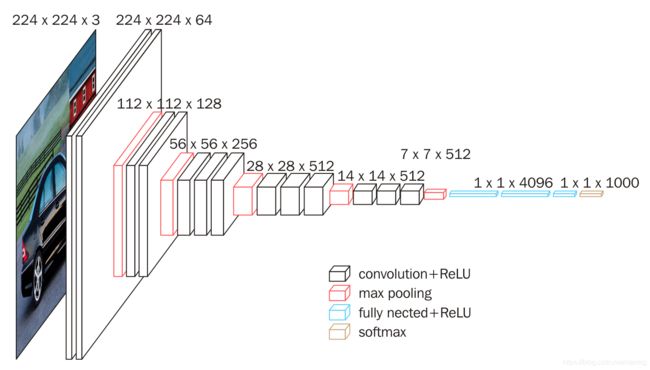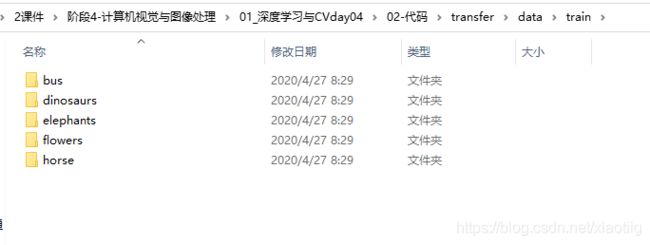图像分类网络6——VGG16识别5分类(ImageDataGenerator和迁移学习)
目录
- 1 VGG16
-
- 1.1 VGG16简介
- 1.2 VGG16结构
- 1.3 VGG16特点
- 2 数据文件
- 3 代码
-
- 3.1 ImageDataGenerator和VGG16迁移学习
- 3.2 VGG16迁移学习+转移矩阵
-
- 3.2.1 训练
- 3.2.2 单张图像预测
- 3.2.3 测试获取准确率
- 3.2.4 批量图像预测实现转移矩阵
1 VGG16
1.1 VGG16简介
VGG是由Simonyan 和Zisserman在文献《Very Deep Convolutional Networks for Large Scale Image Recognition》中提出卷积神经网络模型,其名称来源于作者所在的牛津大学视觉几何组(Visual Geometry Group)的缩写。
该模型参加2014年的 ImageNet图像分类与定位挑战赛,取得了优异成绩:在分类任务上排名第二,在定位任务上排名第一。
论文地址:
https://arxiv.org/abs/1409.1556
1.2 VGG16结构
参考下面两篇文章:
https://www.cnblogs.com/lfri/p/10493408.html
https://baijiahao.baidu.com/s?id=1667221544796169037&wfr=spider&for=pc
1.3 VGG16特点
(1)结构简单,就是一层一层顺序堆叠
(2)卷积层均采用相同的卷积核参数

(3)池化层均采用相同的池化核参数,2*2 的最大池化
(4)网络很深,达到了16层,在当时已经是最深的网络了
(5)参数多,最后3个全连接层的参数太多
需要的存储容量大,不利于部署。例如存储VGG16权重值文件的大小为500多MB,不利于安装到嵌入式系统中。
(6)特征提取能力强,现在很多网络都以vgg16作为特征提取层
2 数据文件
3 代码
3.1 ImageDataGenerator和VGG16迁移学习
# 这个代码有点难懂
import tensorflow as tf
from tensorflow.keras.preprocessing.image import ImageDataGenerator
from tensorflow.keras.applications.vgg16 import VGG16, preprocess_input
import numpy as np
import os
os.environ["TF_CPP_MIN_LOG_LEVEL"] = "2"
class TransferModel(object):
"""VGG迁移学习做5个类别图片识别
"""
def __init__(self):
# 初始化训练集和测试集的迭代器
self.train_generator = ImageDataGenerator(rescale=1.0 / 255.0,
shear_range=0.2,
zoom_range=0.2,
horizontal_flip=True)
self.test_generator = ImageDataGenerator(rescale=1.0 / 255.0)
# 数据目录
self.train_dir = r"H:\05学习资料\14,软件开发\黑马人工智能\2课件\阶段4-计算机视觉与图像处理\01_深度学习与CVday04\02-代码\transfer\data\train"
self.test_dir = r"H:\05学习资料\14,软件开发\黑马人工智能\2课件\阶段4-计算机视觉与图像处理\01_深度学习与CVday04\02-代码\transfer\data\test"
# 定义输入数据的大小和批次大小
self.image_size = (224, 224)
self.batch_size = 32
# 初始化VGG基础模型,
self.base_model = VGG16(weights='imagenet', include_top=False)
self.label_dict = {
'0': 'bus',
'1': 'dinosaurs',
'2': 'elephants',
'3': 'flowers',
'4': 'horse'
}
def get_local_data(self):
"""读取本地的图片数据以及类别标签
:return:
"""
# 1、datagen.flow_from_directory
# 这个函数需要好好看看
# 这里没有用标签,是这个函数自动给赋予了0,1,2,3,4的标签了
train_gen = self.train_generator.flow_from_directory(self.train_dir,
target_size=self.image_size,
batch_size=self.batch_size,
class_mode='binary',
shuffle=True)
test_gen = self.train_generator.flow_from_directory(self.test_dir,
target_size=self.image_size,
batch_size=self.batch_size,
class_mode='binary',
shuffle=True)
return train_gen, test_gen
def refine_base_model(self):
"""
修改VGG的模型,在VGG的5个block,[None, ?, ?, 512]--->全局平均池化-->两个全连接层1024, 5
:return: 新的迁移学习模型
"""
# 1、获取VGG模型的输出,不包含原有模型的top结构
x = self.base_model.outputs[0]
# 2、在VGG的输出之后定义自己的模型
x = tf.keras.layers.GlobalAveragePooling2D()(x)
# 两个全连接层
x = tf.keras.layers.Dense(1024, activation=tf.nn.relu)(x)
y_predict = tf.keras.layers.Dense(5, activation=tf.nn.softmax)(x)
# 3、使用Model封装新的模型返回
transfer_model = tf.keras.models.Model(inputs=self.base_model.inputs, outputs=y_predict)
return transfer_model
def freeze_vgg_model(self):
"""
冻结VGG的前面卷积结构,不参与训练
:return:
"""
# 循环获取base_model当中的层
for layer in self.base_model.layers:
layer.trainable = False
return None
def compile(self, model):
"""
编译模型,指定优化器损失计算方式,准确率衡量
:return:
"""
model.compile(optimizer=tf.keras.optimizers.Adam(),
loss=tf.keras.losses.sparse_categorical_crossentropy,
metrics=['accuracy'])
return None
def fit_generator(self, model, train_gen, test_gen):
"""进行模型训练,注意使用fit_generator,不是fit
:param model:
:param train_gen:
:param test_gen:
:return:
"""
modelckpt = tf.keras.callbacks.ModelCheckpoint('./ckpt/transfer_{epoch:02d}-{val_accuracy:.2f}.h5',
monitor='val_accuracy',
save_best_only=True,
save_weights_only=False,
mode='auto',
period=1)
model.fit_generator(train_gen, epochs=3, validation_data=test_gen, callbacks=[modelckpt])
return None
def predict(self, model):
"""预测输入图片的类别
:return:
"""
# 1、加载模型训练好的权重
model.load_weights("./ckpt/transfer_01-0.93.h5")
# 2、读取图片处理图片数据,形状,数据归一化
image = tf.io.read_file(r"H:\05学习资料\14,软件开发\黑马人工智能\2课件\阶段4-计算机视觉与图像处理\01_深度学习与CVday04\02-代码\transfer\data\test\dinosaurs\402.jpg")
image_decoded = tf.image.decode_jpeg(image)
image_resized = tf.image.resize(image_decoded, [224, 224]) / 255.0
# 3维-->4维的形状改变
img = tf.reshape(image_resized, (1, image_resized.shape[0], image_resized.shape[1], image_resized.shape[2]))
print("修改之后的形状:", img.shape)
# 3、输入数据做预测
y_predict = model.predict(img)
index = np.argmax(y_predict, axis=1)
print('=====', index)
print('-=-=-=', index[0])
print('-=-=-=', type(index[0]))
print('-=-=-=', type(str(index[0])))
print(self.label_dict[str(index[0])])
return None
if __name__ == '__main__':
tm = TransferModel()
# 训练模型步骤
# 1、读取数据
train_gen, test_gen = tm.get_local_data()
# print(train_gen, test_gen)
# 2、定义模型去微调模型和冻结模型
# 3、模型的compile和训练
model = tm.refine_base_model()
print(model.summary())
tm.freeze_vgg_model()
tm.compile(model)
tm.fit_generator(model, train_gen, test_gen)
# # 测试数据
transfer_model = tm.refine_base_model()
tm.predict(transfer_model)
3.2 VGG16迁移学习+转移矩阵
3个文件
一个训练文件
一个单张图像预测文件
一个批量文件预测实现转移矩阵
3.2.1 训练
import tensorflow as tf
import os
#定义一个数据读取的函数,读取指定文件夹下的数据,制作样本数据集
def read_image_filename(data_dir):
building_dir=data_dir+'building/' #得到建筑的文件夹
cloud_dir=data_dir+'cloud/'
farmland_dir = data_dir + 'farmland/'
health_dir = data_dir + 'health/'
infected_dir = data_dir + 'infected/'
water_dir = data_dir + 'water/'
#构建特征数据集,值为对应的图片文件名
building_filenames=tf.constant([building_dir+fn for fn in os.listdir(building_dir)]) #猫的文件名
cloud_filenames=tf.constant([cloud_dir+fn for fn in os.listdir(cloud_dir)])
farmland_filenames = tf.constant([farmland_dir + fn for fn in os.listdir(farmland_dir)])
health_filenames = tf.constant([health_dir + fn for fn in os.listdir(health_dir)])
infected_filenames = tf.constant([infected_dir + fn for fn in os.listdir(infected_dir)])
water_filenames = tf.constant([water_dir + fn for fn in os.listdir(water_dir)])
filenames=tf.concat([building_filenames,cloud_filenames,farmland_filenames,health_filenames,infected_filenames,water_filenames],axis=-1) #对矩阵按行结合
#构建标签数据集,build为0,cloud为1
labels=tf.concat([
tf.zeros(building_filenames.shape,dtype=tf.int32), #猫的数量,并赋值相应数量的0
tf.ones(cloud_filenames.shape,dtype=tf.int32),
tf.fill(farmland_filenames.shape,2),
tf.fill(health_filenames.shape,3),
tf.fill(infected_filenames.shape,4),
tf.fill(water_filenames.shape,5)],
axis=-1) #安行结合
return filenames,labels
#解码图片并调整图片大小
def decode_image_and_resize(filename,label):
image_string=tf.io.read_file(filename) #读取原始文件
#问题1
image_decoded=tf.image.decode_jpeg(image_string) #解码JPEG图片
#调整图像大小,要和后面模型输入要求一致,并进行标准化
image_resized=tf.image.resize(image_decoded,[224,224])/255.0
return image_resized,label
"""
train_data_dir='./smalldata/train/' #文件夹
filenames,labels=read_image_filename(train_data_dir)
dataset=tf.data.Dataset.from_tensor_slices((filenames,labels)) #构建数据集
####print(filenames,labels)
#######print(dataset)
sub_dataset=dataset.take(3) #取出前三项
for x,y in sub_dataset:
print('filename:',x.numpy(),'label:',y.numpy())
"""
#对数据进行预处理
def prepare_dataset(data_dir,buffer_size=2000,batch_size=16):
filenames,labels=read_image_filename(data_dir)
print(filenames.shape)
print(labels.shape)
dataset=tf.data.Dataset.from_tensor_slices((filenames,labels))
dataset=dataset.map(
map_func=decode_image_and_resize, #对dataset中的数据统一进行相同处理
num_parallel_calls=tf.data.experimental.AUTOTUNE
)
dataset=dataset.shuffle(buffer_size)#打乱
dataset=dataset.batch(batch_size) #划好批次
dataset=dataset.prefetch(tf.data.experimental.AUTOTUNE)
return dataset
#vgg16模型
def vgg16_model(input_shape=(224,224,3)):
vgg16=tf.keras.applications.vgg16.VGG16(include_top=False,
weights='imagenet',
input_shape=input_shape)
for layer in vgg16.layers:
layer.trainable=False #设置vgg-16预训练模型不可训练
last=vgg16.output
#加入剩下未经训练的全连接层
x=tf.keras.layers.Flatten()(last)
x=tf.keras.layers.Dense(128,activation='relu')(x)
x=tf.keras.layers.Dropout(0.3)(x)
x=tf.keras.layers.Dense(32,activation='relu')(x)
x=tf.keras.layers.Dropout(0.3)(x)
x=tf.keras.layers.Dense(6,activation='softmax')(x)
#建立新的模型
model=tf.keras.models.Model(inputs=vgg16.input,outputs=x)
model.summary()
return model
#建立模型,模型设置
model=vgg16_model()
model.compile(optimizer='adam',
loss='sparse_categorical_crossentropy',
metrics=['accuracy'])
#训练模型
#下面四步读取训练数据
#定义目录
train_data_dir='./dataset/train/'
#定义缓存大小,用于打乱
buffer_size=10000
#批次大小,每个批次多少样本数
batch_size=16
#训练用的数据集
dataset_train=prepare_dataset(train_data_dir,buffer_size,batch_size)
#定义超参数
training_epochs=4
#进行训练,训练数据,数据训练多少轮
train_history=model.fit(dataset_train,epochs=training_epochs,verbose=1)
"""
# 从训练集选0.2个用于测试,
# model.fit() fit函数参数说明_可乐联盟-CSDN博客 https://blog.csdn.net/LuYi_WeiLin/article/details/88555813
train_history = model.fit(train_dataset,batch_size=batch_size,epochs=training_epochs,
validation_data=validation_dataset,
validation_freq=1,
callbacks=cp_collback,
verbose=1)
# 4模型训练损失和准确率可视化
# 得到参数
acc = train_history.history['sparse_categorical_accuracy']
val_acc = train_history.history['val_sparse_categorical_accuracy']
loss = train_history.history['loss']
val_loss = train_history.history['val_loss']
# 画图,一行两列
plt.subplot(1,1,1) # 一行两列第一列
plt.plot(acc,label="Training Accuracy")
plt.plot(val_acc,label="Validation Accuracy")
plt.plot(loss,label="Training Loss")
plt.plot(val_loss,label="Validation Loss")
plt.title("Accuracy and Loss")
plt.legend()
# 保存和显示
plt.savefig('./result.jpg')
plt.show()
"""
######模型存储
#将模型结构和模型权重参数分开存储
#模型结构存储再.yaml文件中
yaml_string=model.to_yaml()
with open('./models/cat_dog.yaml','w') as model_file:
model_file.write(yaml_string)
#模型权重参数存储在.h5文件中
model.save_weights('./models/cat_dog.h5')
print("模型保存完毕!")
3.2.2 单张图像预测
import tensorflow as tf
from tensorflow.keras.preprocessing import image
import matplotlib.pyplot as plt
import os
import numpy as np
#载入模型
#恢复模型结构
with open('./models/cat_dog.yaml') as yamlfile:
loaded_model_yaml=yamlfile.read()
model=tf.keras.models.model_from_yaml(loaded_model_yaml)
#导入模型的权重参数
model.load_weights('./models/cat_dog.h5')
model.summary()
'''
进行数据测试,显示出准确率的想法
1、读取文件路径 1
2、得到相应的labels 1
3、得到预测结果 1
4、预测结果与labels对比,相同的话t+1,
5、t/totle
'''
###1、2读取文件和labels
while True:
files=input("filepath")
print(files)
###3得到预测结果
#结合原来的两个函数重新定义一个函数,实现数据的预处理和预测
image_size=(224,224)
test_images=[]
img=image.load_img(files,target_size=image_size)
img_array=image.img_to_array(img)
test_images.append(img_array)
test_data=np.array(test_images)
test_data/=255.0
print("The test_data's shape is",end='') #end为空,实现不换行
print(test_data.shape)
preds = model.predict(test_data)
print(preds.shape)
print(preds)
max = np.argmax(preds)
dict = {0:"building",1:"cloud",2:"farmland",3:"health",4:"infected",5:"water"}
print(dict[max])
print("Finish!")
3.2.3 测试获取准确率
import tensorflow as tf
from tensorflow.keras.preprocessing import image
import matplotlib.pyplot as plt
import os
import numpy as np
#载入模型
#恢复模型结构
with open('./models/cat_dog.yaml') as yamlfile:
loaded_model_yaml=yamlfile.read()
model=tf.keras.models.model_from_yaml(loaded_model_yaml)
#导入模型的权重参数
model.load_weights('./models/cat_dog.h5')
'''
进行数据测试,显示出准确率的想法
1、读取文件路径 1
2、得到相应的labels 1
3、得到预测结果 1
4、预测结果与labels对比,相同的话t+1,
5、t/totle
'''
###1、2读取文件和labels
test_data_dir='./dataset/test/'
def read_image_filename(data_dir):
building_dir=data_dir+'building/' #得到建筑的文件夹
cloud_dir=data_dir+'cloud/'
farmland_dir = data_dir + 'farmland/'
health_dir = data_dir + 'health/'
infected_dir = data_dir + 'infected/'
water_dir = data_dir + 'water/'
#构建特征数据集,值为对应的图片文件名
building_filenames=tf.constant([building_dir+fn for fn in os.listdir(building_dir)]) #猫的文件名
cloud_filenames=tf.constant([cloud_dir+fn for fn in os.listdir(cloud_dir)])
farmland_filenames = tf.constant([farmland_dir + fn for fn in os.listdir(farmland_dir)])
health_filenames = tf.constant([health_dir + fn for fn in os.listdir(health_dir)])
infected_filenames = tf.constant([infected_dir + fn for fn in os.listdir(infected_dir)])
water_filenames = tf.constant([water_dir + fn for fn in os.listdir(water_dir)])
filenames=tf.concat([building_filenames,cloud_filenames,farmland_filenames,health_filenames,infected_filenames,water_filenames],axis=-1) #对矩阵按行结合
#构建标签数据集,build为0,cloud为1
labels=tf.concat([
tf.zeros(building_filenames.shape,dtype=tf.int32), #猫的数量,并赋值相应数量的0
tf.ones(cloud_filenames.shape,dtype=tf.int32),
tf.fill(farmland_filenames.shape,2),
tf.fill(health_filenames.shape,3),
tf.fill(infected_filenames.shape,4),
tf.fill(water_filenames.shape,5)],
axis=-1) #安行结合
return filenames,labels
filenames,labels=read_image_filename(test_data_dir)
sess=tf.Session()
#files:./smalldata/test1/dog.11200.jpg
files=sess.run(filenames)
print(len(files))
print(files)
label=sess.run(labels)
print(len(label))
print(label)
###3得到预测结果
#结合原来的两个函数重新定义一个函数,实现数据的预处理和预测
def test_predict(files,image_size=(224,224)):
test_images=[]
# 读取测试图片并进行预处理
for img_filename in files:
img=image.load_img(img_filename,target_size=image_size)
img_array=image.img_to_array(img)
test_images.append(img_array)
test_data=np.array(test_images)
test_data/=255.0
print("The test_data's shape is",end='') #end为空,实现不换行
print(test_data.shape)
preds = model.predict(test_data)
print(preds.shape)
print(preds)
#4,t+1
k=0
t=0 #用于记录准确值
for i in range(0, len(files)):
if np.argmax(preds[i]) == label[i]:
t=t+1
print(t)
else:
print("错误:",files[i])
#5,准确率
accuracy=t/(1.0*len(files))
print("准确率为:",accuracy)
return accuracy
accuracy=test_predict(files)
print("Finish!")
3.2.4 批量图像预测实现转移矩阵
import tensorflow as tf
from tensorflow.keras.preprocessing import image
import matplotlib.pyplot as plt
import os
import numpy as np
#载入模型
#恢复模型结构
with open('./models/cat_dog.yaml') as yamlfile:
loaded_model_yaml=yamlfile.read()
model=tf.keras.models.model_from_yaml(loaded_model_yaml)
#导入模型的权重参数
model.load_weights('./models/cat_dog.h5')
'''
进行数据测试,显示出准确率的想法
1、读取文件路径 1
2、得到相应的labels 1
3、得到预测结果 1
4、预测结果与labels对比,相同的话t+1,
5、t/totle
'''
###图片路径
test_data_dir='E:/6qiege/zx3'
dirs = os.listdir(test_data_dir)
print("一共%d张图像"%(len(dirs)))
# 用于统计个数
building_num = 0
cloud_num = 0
farmland_num = 0
health_num = 0
infected_num = 0
water_num = 0
number = 0
for jpg in dirs:
number +=1
if number%1000 == 0:
print("处理到第%d张."%number)
image_size = (224, 224)
test_images = []
jpgpath='E:/6qiege/zx3/'+jpg
img = image.load_img(jpgpath, target_size=image_size)
img_array = image.img_to_array(img)
test_images.append(img_array)
test_data = np.array(test_images)
test_data /= 255.0
preds = model.predict(test_data)
max = np.argmax(preds)
if max==0:
building_num +=1
if max==1:
cloud_num +=1
if max==2:
farmland_num +=1
if max==3:
health_num +=1
if max==4:
infected_num +=1
if max==5:
water_num +=1
print("建筑%d张" % building_num)
print("云体%d张" % cloud_num)
print("农田%d张" % farmland_num)
print("健康林%d张" % health_num)
print("受害木%d张" % infected_num)
print("水体%d张" % water_num)






